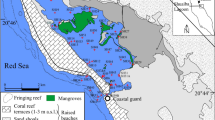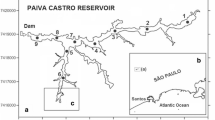Abstract
The levels and distribution of trace metals (Cr, Mn, Co, Ni, Cu, Zn, Cd and Pb) at eleven water and sediment stations on the Little Akaki River (LAR) in Addis Ababa, Ethiopia, were determined. The binding forms of the metals in various geochemical fractions of the sediments were also quantified. The molar ratio of the sum of the simultaneously extractable metals (∑SEM) and acid-volatile sulphide (AVS)—as a measure for predicting metal-induced toxicity—was estimated. LAR trace levels in water for Cu, Zn, and, particularly Mn were, in most instances, higher than the recommended guidelines for healthy aquatic ecosystems. Total trace metal (TTM) contents in the LAR sediments at certain stations exceeded “threshold effect concentrations” and even “probable effect concentrations”, especially in the cases of Zn, Cu, Ni, Pb, and at all stations for Mn. This became more apparent after applying “normalizations” to the relatively lower TTM adsorption capacities of coarse-grained, organic-poor sediments. Sequential extraction of the sediments showed that trace metals generally have a higher affinity for Fe-Mn oxide and organic matter/sulphidic fractions, followed by the residual fraction. Mn was relatively strongly bound to the exchangeable, carbonate bound fractions, whereas a large proportion of Cr was found in the residual fraction. The Σ[SEM]/[AVS] ratio pointed to potential metal-induced toxicity of sediments collected from seven out of the eleven stations. The results indicate that trace metal pollution pose risks to the health of ecosystems, and to human communities that use the river for a range of different purposes.



Similar content being viewed by others
References
Akele, M. L. (2012). MSc thesis WM. In Assessment of trace metals distibution in sediments of the Little Akaki River (pp. 12–16). Addis Ababa, Ethiopia: UNESCO-IHE.
Alemayehu, T. (2006). Heavy metal concentration in the urban environment of Addis Ababa, Ethiopia. Journal of Soil and Sediment Contamination, 15(6), 591–602.
Alemayehu Abiye, T., Sulaiman, H., & Hailu, A. (2011). Metal concentration in vegetables grown in the hydrothermally affected area in Ethiopia. Journal of Geography and Geology, 3(1), 86–93.
Anonymous (2016). Ministry of housing, spatial planning and the environment: http://wetten.overheid.nl/BWBR0023085/2016-01-01; accessed on April 10, 2016.
Argese, E., & Bettiol, C. (2001). Heavy metal partitioning in sediments from the lagoon of Venive (Italy). Toxicological and Environmental Chemistry, 78(3–4), 157–170.
AWDR. (2006). Protecting ecosystems in Africa. African Water Development Report, 2006.
Baruah, N. K., Kotoky, P., Bhattacharyya, K. G., & Borah, G. C. (1996). Metal speciation in Jhanji River sediments. Science of the Total Environment, 193(1), 1–12.
Chapman, D. (1996). Water quality assessments: a guide to use of biota, sediments and water in environmental monitoring (2nd ed.). Cambridge, UK: Cambridge University Press.
DaSilva, I. S., Abate, G., Lihtig, J., & Masini, J. C. (2002). Heavy metal distribution in recent sediments of the Tietê-Pinheiros system in São Paulo State, Brazil. Applied Geochemistry, 17(2), 105–116.
Donze, M. (1990). Shaping the Environment: aquatic pollution and dredging in the European community. The Hague, the Netherlands: Delwel.
Duke, L. D., Buffleben, M., & Bauersachs, L. A. (1998). Pollutants in storm water runoff from metal plating facilities, Los Angeles, California. Waste Management, 18(1), 25–38.
ESRD. (2014). Environmental quality guidelines for Alberta surface waters. Edmonton, Canada: Water Policy Branch, Policy Division.
Fang, T., Li, X., & Zhang, G. (2005). Acid volatile sulfide and simultaneously extracted metals in the sediment cores of the Pearl River Estuary, South China. Ecotoxicology and Environmental Safety, 61(3), 420–431.
Förstner, U., & Wittmann, G. T. W. (1983). Metal pollution in the aquatic environment. Berlin, Germany: Springer Verlag.
Håkanson, L., & Jansson, M. (1983). Lake sedimentolog. Berlin, Germany: Springer Verlag.
Houba, V. J. G., Van der Lee, J. J., & Novozamsky, J. (1995). Soil analysis procedures. Lecture notes #6175208. Wageningen, the Netherlands: Wageningen University and Research.
Jaagumagi, R. (1992). Development of the Ontario Provincial Sediment Quality Guidelines for Arsenic, Cadmium, Chromium, Copper, Iron, Lead, Manganese, Mercury, Nickel, and Zinc. Ministry of the Environment. http://www.archive.org/stream/developmentofont00jaaguoft#page/n1/mode/2up; accessed July 7, 2014.
Kelderman, P. (2012). Sediment pollution, transport, and abatement measures in the city canals of Delft, the Netherlands. Water, Air, & Soil Pollution, 223(7), 4627–4645.
Kelderman, P., & Osman, A. A. (2007). Effect of redox potential on heavy metal binding forms in polluted canal sediments in Delft (The Netherlands). Water Research, 41(18), 4251–4261.
Kiratli, N., & Ergin, M. (1996). Partitioning of heavy metals in surface Black Sea sediments. Applied Geochemistry, 11(6), 775–788.
Li, P., Qian, H., Howard, K. F., Wu, J., & Lyu, X. (2014). Anthropogenic pollution and variability of manganese in alluvial sediments of the Yellow River, Ningxia, northwest China. Environmental Monitoring and Assessment, 186(3), 1385–1398.
Lin, J., Chen, S., & Su, C. (2003). Assessment of sediment toxicity by metal speciation in different particle-size fractions of river sediment. Water Science and Technology, 47(7–8), 233–241.
MacDonald, D. D., Ingersoll, C., & Berger, T. (2000). Development and evaluation of consensus-based sediment quality guidelines for freshwater ecosystems. Archives of Environmental Contamination and Toxicology, 39(1), 20–31.
Malaj, E., Rousseau, D., Du Laing, G., & Lens, P. (2012). Near-shore distribution of heavy metals in the Albanian part of Lake Ohrid. Environmental Monitoring and Assessment, 184, 1823–1839.
Mekkonen, K. N., Ambushe, A. A., Chandravanshi, B. S., Abshiro, M. R., & McCrindle, R. I. (2013). Assessment of the concentration of Cr, Mn and Fe in sediment using laser-induced breakdown spectroscopy. Bulletin of the Chemical Society of Ethiopia, 27(1), 1–13.
Melaku, S., Wondimu, T., & Dams, R. L. M. (2005). Multi-element analysis of Tinishu Akaki River Sediment, Ethiopia, by ICP-MS after microwave assisted digestion. Canadian Journal of Analytical Sciences and Spectroscopy, 50(1), 31–40.
Melaku, S., Wondimu, T., Dams, R., & Moens, L. (2007). Pollution status of Tinishu Akaki River and its tributaries (Ethiopia) evaluated using physico-chemical parameters, major ions, and nutrients. Bulletin of the Chemical Society of Ethiopia, 21(1), 13–22.
Miller, J. R., & Orbock Miller, S. M. (2007). Contaminated rivers: a geomorphological-geochemical approach to site assessment and remediation. Dordrecht, the Netherlands: Springer.
Nemerow, N. L. (1978). Industrial water pollution. Reading, UK: Addison-Wesley.
Okonkwo, J. O., & Mothiba, M. (2005). Physico-chemical characteristics and pollution levels of heavy metals in the rivers in Thohoyandou, South Africa. Journal of Hydrology, 308(1–4), 122–127.
Pardo, R., Barrado, E., Lourdes, P., & Vega, M. (1990). Determination and speciation of heavy metals in sediments of the Pisuerga river. Water Research, 24(3), 373–379.
Prabu, P. (2009). Impact of heavy metal contamination of Akaki River of Ethiopia on soil and metal toxicity on cultivated vegetable crops. Electronic Journal of Environmental, Agricultural and Food Chemistry, 8(9), 818–827.
Prica, M., Dalmacija, B., Rončević, S., Krčmar, D., & Bečelić, M. (2008). A comparison of sediment quality results with acid volatile sulfide (AVS) and simultaneously extracted metals (SEM) ratio in Vojvodina (Serbia) sediments. Science of the Total Environment, 389(2–3), 235–244.
Ramos, L., Gonzalez, M., & Hernandez, L. (1999). Sequential extraction of copper, lead, cadmium, and zinc in sediments from Ebro river (Spain): relationship with levels detected in earthworms. Bulletin of Environmental Contamination and Toxicology, 62(3), 301–308.
Standard methods for the examination of water and wastewater (2005). 21st edn, American Public Health Association/ American Water Works Association/Water Environment Federation, Washington DC, USA.
Stumm, W., & Morgan, J. (1981). Aquatic chemistry. New York, USA: J Wiley and Sons.
Teixeira, E. T., Ortiz, L. O., Alves, M. A., & Sanchez, J. S. (2001). Distribution of selected heavy metals in fluvial sediments of the coal mining region of Baixo Jacuí, RS, Brazil. Environmental Geology, 41(1), 145–154.
Tessier, A., Campbell, P. G. C., & Bisson, M. (1979). Sequential extraction procedure for the speciation of particulate trace metals. Analytical Chemistry, 51(7), 844–851.
Thomann, R. V., & Müller, J. A. (1987). Principles of water quality and control. New York, USA: Harper and Row.
Tokalioğlu, Ş., Kartal, Ş., & Elçi, L. (2000). Determination of heavy metals and their speciation in lake sediments by flame atomic absorption spectrometry after a four-stage sequential extraction procedure. Analytica Chimica Acta, 413(1–2), 33–40.
Tsai, L. J., Yu, K. C., Chang, J. S., & Ho, S. T. (1998). Fractionation of heavy metals in sediment cores from the Ell-Ren river, Taiwan. Water Science and Technology, 37(6–7), 217–224.
USEPA. (2004). The incidence and severity of sediment contamination in surface waters of the United States (2nd edn). Washington DC, USA: National Sediment Quality Survey.EPA 823-R-04-007.
Van den Hoop, M. A. G. T., Den Hollander, H. A., & Kerdijk, H. N. (1997). Spatial and seasonal variations of acid volatile sulphide (AVS) and simultaneously extracted metals (SEM) in Dutch marine and freshwater sediments. Chemosphere, 35(10), 2307–2316.
Van Rooijen, D., Biggs, T., Smout, I., & Drechsel, P. (2010). Urban growth, wastewater production and use in irrigated agriculture: a comparative study of Accra, Addis Ababa and Hyderabad. Irrigation and Drainage Systems, 24(1), 53–64.
WHO. (2011). Guidelines for drinking water quality (4th ed.). Geneva, Switzerland: WHO.
Yin, H. B., Fan, C. X., Ding, S. M., Zhang, L., & Zhong, J. C. (2008). Geochemistry of iron, sulfur and related heavy metals in metal-polluted Taihu Lake sediments. Pedosphere, 18(5), 564–573.
Yu, K. C., Tsai, L. J., Chen, S. H., & Ho, S. T. (2001). Chemical binding of heavy metals in anoxic river sediments. Water Research, 35(17), 4086–4094.
Acknowledgments
The authors acknowledge Don van Galen and Lyzette Robbemont, UNESCO-IHE, for their invaluable laboratory assistance. This research was financially supported by the Netherlands Fellowship Program (NFP).
Author information
Authors and Affiliations
Corresponding author
Rights and permissions
About this article
Cite this article
Akele, M.L., Kelderman, P., Koning, C.W. et al. Trace metal distributions in the sediments of the Little Akaki River, Addis Ababa, Ethiopia. Environ Monit Assess 188, 389 (2016). https://doi.org/10.1007/s10661-016-5387-z
Received:
Accepted:
Published:
DOI: https://doi.org/10.1007/s10661-016-5387-z




